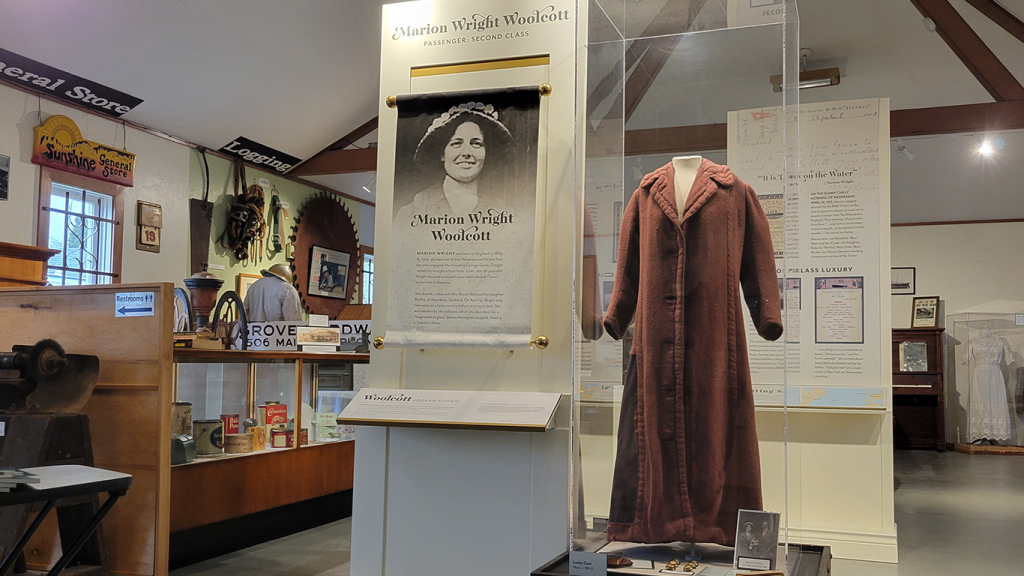COTTAGE GROVE – Just off North River Road sits a quiet neighborhood full of relics.
The location is deeply rooted in the neighborhood’s history. Crank your head up and look for Mount David, a landmark in Cottage Grove’s landscape generally known as “the backyard of the community,” where motorcycle races were once held, and a bygone pioneer cemetery sits gated on its slope.
You’ll know you’re in the right part of town if you see an eight-sided historic church; it is believed to be the only octagonal building west of the Mississippi.

On North H Street and in a cluster of nearby buildings, volunteers sift through artifacts, carefully cataloging and preserving the precious, extensive collection—half of which remains squirreled away beyond the exhibit displays.
At the museum, you’ll find anything from signed quilts from local legends to a “timely exhibit” of calendars from long-gone storefronts to posters, books, and even displays of Cottage Grove High alumni.

Becky Venice, Cottage Grove Museum board chair, lives across the street from the museum. Her involvement was a natural progression from being a neighborhood resident to becoming actively engaged in preserving local history.
“I’ve lived in Cottage Grove since 1964, raised six kids across the street,” Venice said. “I have a daughter with a disability, and so I was an advocate for people with disabilities. I did trainings all over the state, other states, and Washington, D.C.”
Venice brought organizational and advocacy skills to museum management. Those skills and her interest in community service amalgamated after she buddied up with other history enthusiasts through the historical steward group Friends of Mount David and when she joined the museum board about 15 years ago.

Since then, Venice and a committed volunteer base have worked to transform the museum’s approach to collecting and maintaining artifacts. Described as once akin to a storage attic with a barely carved-out walking path, now the space feels like a professional, well-organized historical repository with proper preservation and exhibition practices.
They did learn a thing or two about handling artifacts of their crown jewel — the Woolcott Titanic coat — from “the big guys.”
In 2018, the National Geographic Museum in Washington, DC, invited Cottage Grove to loan the coat for its permanent exhibit, “She Survived the Titanic: The Story of Marion Wright Woolcott. ” The exhibit showcases the coat worn and the story behind the Cottage Grove resident who was rescued from the ship.

An archaeologist and NatGeo representative personally transported the coat, and Venice and three other volunteers traveled to Washington, DC, to see the exhibit. They met Bob Ballard there, who first discovered the Titanic underwater in 1985.
The experience helped “put them on the map,” Venice said, and improved their preservation efforts. When the museum borrowed the coat for its Titanic exhibit, it returned it and provided the impressive display case and a mannequin.
“This kind of stuff is very expensive, and we’re a volunteer-run organization. We don’t have that kind of money,” she said.
Preservation efforts
Museum volunteer Cathy Bellavita said properly storing and cataloging artifacts is a science – and ethical obligation.
“When you accept something, you accept responsibility for the preservation and storage of that thing. And that is a big responsibility,” Bellavita said. “You gotta track it. You gotta assess it,” she said.

Acidic materials can cause fabrics to deteriorate. Venice said silk items are particularly vulnerable, recalling finding a black silk dress that “just fell apart” when volunteers tried to handle it. She said plastic bag storage is the biggest sin, followed by storage in non-acid-free containers like vinyl totes and wooden chests, to name a few.
“We have these huge boxes that are like $70 a piece that are acid-free, and acid-free tissue that we wrap (items) in to preserve them better,” she said, adding that preservation is an ongoing, complex process that requires continuous learning.

Digitization is also underway at the museum. Bellavita said the over 600 historic images – many scanned from negatives from before 1920 – are now available on the museum’s website. They started digitizing their photo archives after working on a project with the Buster Keaton photograph collection, as she sees digitization as both a preservation method and a way to increase public access to historical materials.
“Digitization helps in preservation and accessibility, but it is a time-consuming process,” Bellavita said, adding that digitizing artifacts is more complex than photographs. Each record takes significant time to enter, requiring photos and detailed documentation to track and catalog each item.
Roping in more locals
While Venice said that the museum sees a lot of out-of-town traffic, residents are too unaware of its existence.
“People are always learning about it, even people who have lived here for a long time. I would say half of our visitors are from out of town,” Venice said. “People in town, sometimes they’ll stop and say ‘We didn’t even know about this!’” adding that they’ll often end up getting sucked into the exhibits for hours and sometimes discover family history hidden in the displays.

They do their best to engage despite having sparse resources. They developed a “passport” program for school children to visit historical sites, offer special tours for retirement communities, host events like an upcoming school reunion, and rotate exhibits to keep things fresh.
And keeping things fresh is easier with fresh sets of eyes.
Venice said the museum always looks for committed volunteers to help catalog artifacts, maintain exhibits, give tours, digitize collections, and assist in Saturday duty rotations. Interested individuals can contact the museum through their website or visit during open hours to learn more about volunteer opportunities.
Cottage Grove Museum is located at 147 N. H St. and is open Saturdays and Sundays from 1-4 p.m. Admission is free, and donations are accepted. For more info, call 541-649-1382 or email museumcottagegrove@gmail.com. Mail donations to PO Box 142, Cottage Grove, OR 97424.




